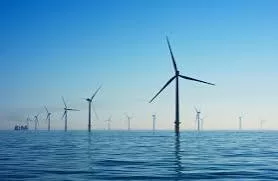The Bureau of Ocean Energy Management (BOEM) has signed the first research contract in maine for floating offshore wind energy in United States, which is 15,000 acres large. This unprecedented lease is located 28 nautical miles from the coast of Maine on the U. S. Outer Continental Shelf and is to become home to between 6 and 12 operating floating offshore wind turbines, which will have the capacity to produce up to 144MW of green energy.
Project factsheet
- Constructor: Bureau of Ocean Energy Management (BOEM) and partners
- Start date: Lease application submitted in October 2021
- Completion date: Lease approved in May 2024; construction expected within a few years
- Cost: $48.6 million from U.S. Department of Energy’s Wind Energy Technologies Office
- Location: 28 nautical miles off the coast of Maine, covering 15,000 acresConstructor: Bureau of Ocean Energy Management (BOEM) and partners
The project is an intergovernmental thrust, including fish-ermen of Maine state, marine life scientists, and offshore wind energy developers to explore the viability of floating wind energy, appraise the potential effects on the environment, and assess the coexistent use of the seas by offshore wind plants and other users. “Floating wind brings possibilities for generating clean electricity deeper and beyond the existing coastline, thus offering benefits for everyone,” BOEM director Elizabeth Klein emphasized.
Funding
The primary source of funding for the US’s 2030 offshore wind capacity objectives is the US Department of Energy’s Wind Energy Technologies Office, which said that it would provide $48. 6m Offshore Wind National and Regional Research and Development Funding Opportunity in July.
In October 2021, the State of Maine submitted an application to BOEM for the lease, and the Agency approved it in May 2024.

Maine Governor Janet Mills identified offshore winds as historic chances for Maine and posited that it would lead to quality employment opportunities, decrease reliance on fossil fuels, and slow down climate change by decreasing greenhouse gas emissions. The Department of the Interior, as part of the Biden-Harris administration, has permitting nine zones with over 13GW of capacity, sufficient to power approaching 5m homes with mother-offshore wind. To date, it has offered five offshore wind lease auctions, including the historical sales of the New York bight and new areas like the Pacific coast and the Gulf of Mexico, and has identified up to 12 more lease sales until 2028.
Scope
Maine is still managing the implementation of the Offshore Wind Roadmap that is meant to provide clean power for economic development while moving the offshore wind investment and innovation from the federal to state level, supporting local seafood industry, and preserving the Gulf of Main environment.
The State of Maine provided a lease application for renewable energy research in 2021 and BOEM considered it and issued Determination of No Competitive Interest in March 2023, followed by completion of environmental assessment in May 24, 2024 before offering the lease to Maine.
Specifically, Maine or its operator for the research lease will assess both the environment and the engineering feasibility of the project, with results disclosed to the public to inform future floating offshore wind projects that go commercial scale. Although construction activity associated with the research array is expected not to commence for the next few years, a lessee desiring to undertake research activities on the structure is required to provide BOEM with a Research Activities Plan that will trigger NEPA environmental analysis.
Read also New York City launches construction of the largest dedicated offshore wind port in the USA
Read also Construction of US’ First Fourth-gen Nuclear Reactor ‘Hermes’ Commences

